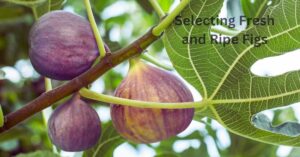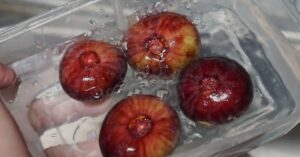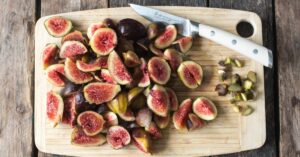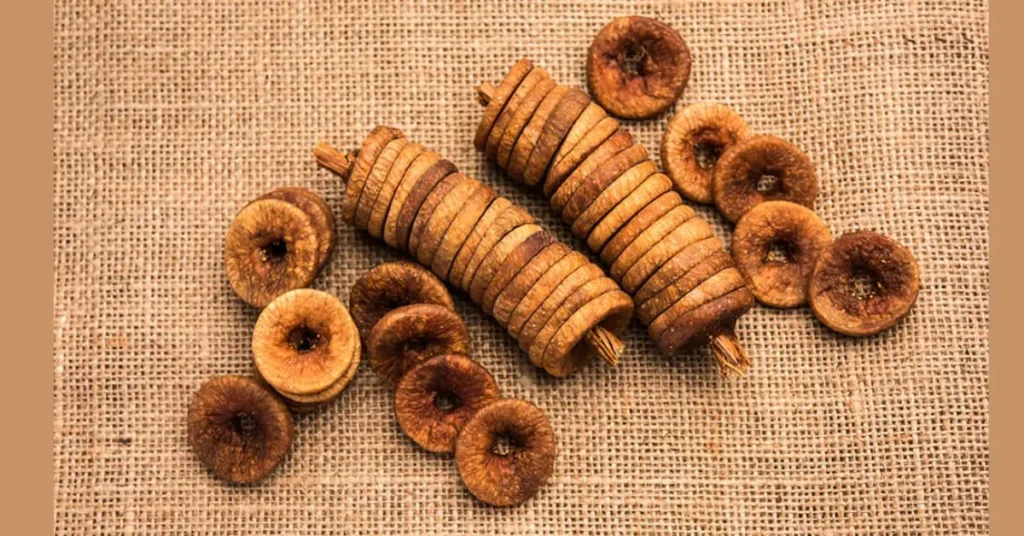An excellent technique to preserve and savour figs’ natural sweetness all year is to dry them, also known as anjeer. Drying figs is an easy and satisfying project, whether you are harvesting an excess of fresh figs from your yard or you want to take advantage of a fantastic deal at the grocery store. This guide steps you through the process to certify always perfectly How to Dry Anjeer.
Why Is Drying Figs Necessary?
Dried figs are a useful and satisfying technique with several benefits over eating fresh figs. Here are three strong arguments in favour of drying figs for preservation:
Extended Shelf Life
Fresh figs are highly perishable and usually only survive for five days or less. By drying them, figs keep much longer on the shelf, giving you more time to savour this tasty fruit.
Dried figs’ shelf life: Depending on the storage environment, dried figs can be kept for six months to a year. Because of their extended shelf life, they’re a handy and readily available snack or ingredient—especially when fresh figs aren’t in season.
Excellent Nutritious Value:
Dense in Dietary Fiber: When compared to fresh figs, dried figs have a higher dietary fibre content. Their high fibre content makes them a great natural solution for digestive problems, supporting a healthy digestive system.
Rich in Antioxidants and Phenolic Compounds
Dried figs have higher levels of antioxidants and phenolic compounds. These substances are important for avoiding free radical-induced cell damage and promoting general health and well-being.
Adaptability in Gastronomic Uses:
Chewy Texture and Sweet Flavor: Dried figs are a popular snack and cooking ingredient due to their distinct chewy texture and enhanced sweetness.
Adding Dried Figs to a Variety of cuisines: Dried figs make a delicious snack or can be included in various cuisines. Add them to trail mix, bake or sauté with them to add flavour and texture, or toss them into salads for natural sweetness.
Rehydrating Dried Figs for Culinary Creativity: Dried figs plump by soaking them in water. They become more adaptable in recipes like fig preserves, desserts, and savoury dishes.
By drying figs’ nutritional value, shelf life, and culinary flexibility, you may increase them. Dried figs provide a handy and tasty way to enjoy this lovely fruit, whether as a nutritious snack or added to various culinary dishes.
Choosing the Right Figs
Selecting Fresh and Ripe Figs
Before you start the drying process, choosing the right figs is crucial. Look for figs that are ripe but not overly soft. They should be slightly plump and have a rich colour.

Varieties of Figs
Different varieties of figs have distinct flavours and textures. Common varieties include Black Mission, Brown Turkey, and Calimyrna. Each type brings a unique taste to your dried figs.

Washing and Cleaning

Gentle Rinse
Start by gently rinsing the figs under cool, running water. Be careful not to bruise or damage the delicate skin.
Pat Dry
After rinsing, pat the figs dry with a clean kitchen towel. This helps remove excess moisture, promoting efficient drying.
Preparing Figs for Drying

Removing Stems
Carefully remove the stems from each fig using a sharp knife or kitchen shears. This ensures a uniform drying process.
Optional: Slice Figs
While you can dry whole figs, slicing them into halves or quarters accelerates the drying time and creates bite-sized pieces.
How to Dry Anjeer: 3 Ways to Anjeer Drying
- Sun Drying
- Oven Drying
- Dehydrator Method
How to Dry Anjeer in the Sunlight
Anjeer, or figs, are preserved and made sweeter through a natural, age-old process called sun drying. With the help of this old method, you may have delicious dried figs with a different flavour and surface. This section will analyse the technique of sun-drying anjeer and offer detailed tips for a fruitful result.
Sun Drying Process
Choosing the Right Location
- Sunny Spot: Place the prepared figs on drying trays in a location with ample sunlight. A sunny, well-ventilated area is ideal.
Trays and Spacing
- Single Layer: Arrange the figs in a single layer on the drying trays, ensuring they are not touching. This promotes even drying.
Turning Figs
- Rotate Periodically: Turn the figs occasionally to ensure all sides receive equal sunlight exposure. This helps in achieving uniform drying.
Sun Drying Duration
- Patience is Key: Sun drying can take several days, depending on the intensity of sunlight and humidity. Be patient and allow nature to work its magic.
Testing for Doneness
- Check Consistency: The figs are ready when dry, slightly leathery, and have a chewy texture. They should not feel sticky or moist.
How to Dry Anjeer in the Oven Heat
Oven-drying anjeer, or figs, is a convenient and efficient process that allows you to enjoy the sweet, chewy goodness of dried figs at any time. This controlled strategy harnesses the heat of your oven to drain the figs, keeping their natural tastes gently.
Preheating the Oven
- Lowest Temperature: Preheat your oven to its lowest setting, typically around 140°F (60°C). This low temperature ensures a slow and even drying process.
Arranging on Baking Sheets
- Single Layer: Place the prepared figs in a single layer on baking sheets. Ensure they are not touching, allowing air to circulate freely.
Propping Open the Oven Door
- Maintain Airflow: Open the oven door slightly with a wooden spoon or oven-safe object. This encourages proper airflow and prevents excess moisture buildup.
Monitoring and Turning
- Regular Checks: Keep a close eye on the figs and turn them occasionally for uniform drying. The drying time can range from 8 to 12 hours.
Testing for Doneness
- Chewy Texture: The figs are ready when dry, slightly leathery, and have a chewy texture. They should not feel sticky or moist.
How to Dry Anjeer in the Dehydrator Method
The dehydrator process for drying anjeer, or figs, offers precise and controlled conditions to keep the natural sweetness and consistency of the fruit. You can efficiently dehydrate figs to create a delicious, chewy snack. We’ll take you through the step-by-step process of using a dehydrator to achieve perfect dried anjeer.
Dehydrator Drying Process
Setting the Temperature
- Follow Dehydrator Instructions: Set your dehydrator to the recommended temperature for figs, typically around 135°F (57°C).
Arranging Dehydrator Trays
- Single Layer: Place the prepared figs on the dehydrator trays in a single layer. Ensure they are not touching for optimal airflow.
Periodic Checking and Turning
- Regular Monitoring: Check the figs periodically and turn the trays to promote even drying. The drying process usually takes 8 to 12 hours.
Testing for Doneness
- Chewy Texture: The figs are ready when dry, slightly leathery, and have a chewy texture. Avoid any stickiness or residual moisture.
Storing Dried Figs
Dried figs, or anjeer, are a delightful and nutritious snack. Proper storage is important to keeping flavour, texture, and overall quality. Follow to ensure your dried figs stay fresh and enjoyable over an extended period.
1: Cooling Before Storage:
Allow your dried figs to cool completely before storing. This helps prevent condensation inside the storage container.
2: Choosing the Right Container:
Use airtight containers or vacuum-sealed bags to store dried figs. This helps keep out moisture and prevents the figs from becoming overly dry.
3: Avoiding Moisture:
Moisture is the enemy of dried figs. Ensure that the storage container is completely dry before placing the figs inside. Any residual moisture can lead to mould growth.
4: Optimal Storage Conditions:
Store dried figs in a cool, dark place. Exposure to light and heat can cause them to lose flavour and texture. A pantry or cupboard is an ideal location.
5: Refrigeration (Optional):
While it’s not mandatory, storing dried figs in the refrigerator can extend their shelf life. This is mainly useful in warmer weather.
6: Freezing (Long-Term Storage):
If you plan to store dried figs for an extended period, consider freezing them. Place the figs in a freezer-safe, airtight container or vacuum-sealed bag.
Frequently Asked Questions (FAQs): How to Dry Anjeer
Q1: Can I sun dry figs without slicing them?
A1: Yes, you can sun-dry whole figs. Slicing them, however, accelerates the drying process and creates convenient, bite-sized pieces.
Q2: What if the weather is cloudy during the drying process?
A2: If sunlight is intermittent, you can bring the trays indoors during cloudy periods and return them to the sun when it reappears.
Q3: Are there any additives needed for sun drying?
A3: No additives are necessary for sun-drying figs. The process relies on the sun’s natural heat and airflow.
Q4: Can I sun dry figs in a dehydrator?
A4: While the process differs, you can achieve similar results using a dehydrator with a low-temperature setting.
Q5: Is it necessary to rotate trays in the dehydrator?
A2: Rotating trays helps ensure even drying, especially if your dehydrator has multiple trays.
Q6: Can I store dehydrated figs in the refrigerator?
A3: While not necessary, storing dehydrated figs in the refrigerator can extend their shelf life.
Q7: Can I use a higher oven temperature for faster drying?
A1: Using the lowest temperature to preserve the figs’ natural flavours and textures is recommended. Higher temperatures can lead to uneven drying.
Q8: How long does it take to oven-dry figs?
A2: The drying time depends on the fig size and oven temperature. Typically, it ranges from 8 to 12 hours.
Q9: Can I add sugar or spices before oven drying?
A3: You can enhance the flavour by sprinkling figs with sugar or adding spices like cinnamon before drying.
Q10: Can I oven-dry figs with the skin on?
A4: Yes, you can oven-dry figs with the skin on. However, removing the skin can speed up the drying process.
Enjoy the convenience of oven-drying anjeer to create a sweet and nutritious snack. With the warmth of your oven, you can savour the rich flavours of dried figs any time of the year.
Q11: Can I store dried figs with other dried fruits?
A1: Yes, you can store dried figs with other dried fruits. However, keeping fruits with similar textures together is advisable to prevent potential flavour transfer.
Q12: Should I store dried figs in the refrigerator immediately after drying?
A2: No, allow the dried figs to cool completely before refrigerating. Rapid temperature changes can lead to condensation, which may affect the quality of the figs.
Q13: How long do dried figs last in storage?
A3: Dried figs can last several months when stored properly in a cool, dark place. Refrigeration or freezing can further extend their shelf life.
Q14: Can I store dried figs in a decorative, open container?
A4: While it may look aesthetically pleasing, it’s best to store dried figs in airtight containers to prevent exposure to air and maintain their freshness.


